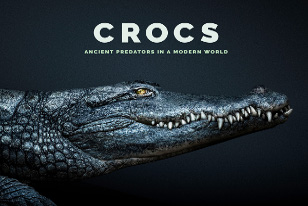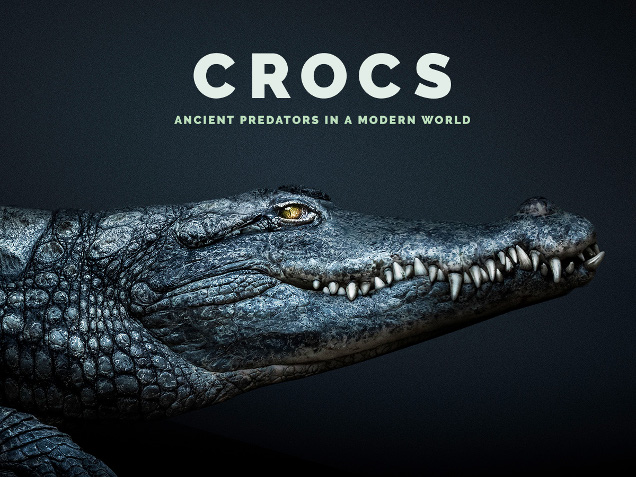Crocs: Ancient Predators in a Modern World
February 3–May 6, 2018


Come face-to-snout with live crocodilians, a group of reptiles that has evolved and thrived for 200 million years thanks to their brute strength, keen senses, and murderous instincts. Today’s crocs range from diminutive forest dwellers to monstrous creatures that eat wildebeests, buffaloes, and occasionally people. Their ancestors were the galloping land predators, jumping insect eaters, pug-nosed herbivores, and ocean-going filter-feeders that haunted our waters and our dreams.
Crocs introduces visitors to one of the most exciting and primal groups of animals through the presentation of amazing live animals, realistic croc models, engaging interactive activities, and informative videos. The exhibit explores the rich and complex lives of alligators, crocodiles, caimans and gharials—their evolutionary history, biology and behavior, and their precarious relationship to people.
What is there to do in Crocs?
- Check out live species, including the Siamese crocodile, the broad-snouted caiman, the American alligator, and the West African dwarf crocodile
- Peek into a real living alligator nest
- Learn to speak croc in under five minutes
- Test your strength against a croc’s bite
- Check out awesome skulls
- Make water dance
- Create a 3-D animation of a long-extinct croc
- Learn all about croc attacks
- “Meet the Keeper” every Wednesday, Saturday, and Sunday at 11:45 a.m. The keeper will share fun facts about the species in the exhibit and answer questions about crocodilians.
$5 for nonmembers in addition to general admission; $3 for individual and family members. Family plus members and above see it free.

Crocs Closing Weekend
Saturday and Sunday, May 5–6
Come join us this weekend to celebrate the terrifying, scaly, and toothy live crocodilians in Crocs: Ancient Predators in a Modern World one last time. Revel in their remarkable and ferocious adaptations, build your own crocodile, and see how you measure up against these brutal beasts. Check out our live animal shows featuring some of the closest relatives of crocodilians, and find out what you can do to help preserve their natural habitat. Sink your teeth in before they are gone!
Auditorium Show: Crocodile Kin
11 a.m. and 2:30 p.m.
Meet some of our scaly and feathery animal ambassadors that call the Academy home to learn more about the kooky connections between birds and crocs.
Archosaur Arena
Design your very own crocodilian with bricks, enjoy a fierce game of “Feed the Croc,” and learn how to move and groove like a crocodile at our gaming station. Find out what an archosaur is and how birds and crocs are related!
Crocodilian Conservation Station
What are the looming dangers threatening crocs around the world? What can you do to help protect them? Find out!
Crocodiles Rock!
Check out real Academy specimens, talk to reptile experts, and see how you measure up to some of the biggest crocodiles that ever sprawled on four legs. Discover the difference between an alligator, a crocodile, and a caiman, and find out how they navigate the world through their acute senses.
CROC Talk
11:45 a.m.
Enjoy a special keeper talk by Katie Baum, Reptiland zookeeper and reptile expert, included with admission to Crocs: Ancient Predators in a Modern World.
Crocodile Crafts
Make and take a craft featuring everyone’s favorite carnivores: crocs!

Live American alligator in Crocs: Ancient Predators in a Modern World
Crocs: Ancient Predators in a Modern World was created by Clyde Peeling’s Reptiland in Allenwood, Pa.
How much do you know about crocs? Test your knowledge, then scroll down for the answers!
- ___________ was an extinct croc that may have eaten big dinosaurs.
- TRUE or FALSE? Crocodilians are more closely related to birds than they are to lizards.
- TRUE or FALSE? Croc fossils have been found on every continent except Antarctica.
- Sarcosuchus imperator had more than __________ teeth lining its massive jaws.
- In cold weather American alligators go through a dormant state called ___________.
- ___________ are bony disks embedded in the skin of crocodilians.
- TRUE or FALSE? A croc may go through as many as 15,000 teeth in its lifetime.
- Crocodilians communicate with sight, sound, ___________, and ___________.
- __________ species of crocs are now considered critically endangered.
- TRUE or FALSE? People living in Australia are more likely to drown than to be killed by a croc.
- What was the first animal to be removed from the U.S. endangered species list?
Answers
1: Deinosuchus; 2: True; 3: False, every continent including Antarctica; 4.: 100; 5: Brumation; 6: Osteoderms; 7: False, more like 3,000-4,000; 8: Chemical cues and touch; 9. 7; 10. True; 11: American alligator